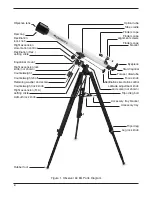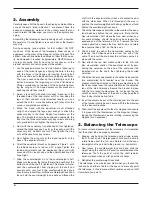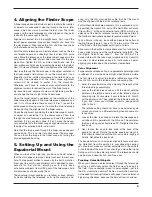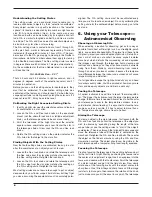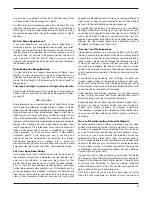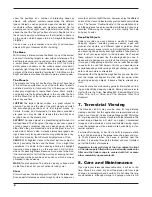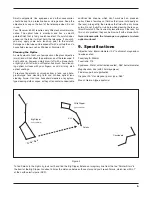
7
can only focus on objects at least 50 to 100 feet away. It will
not focus without the star diagonal in place.
As with all refractor telescopes used with a standard 90° star
diagonal, the image you see will be right-side up, but reversed
left-to-right. (Correct-image diagonals are available, and may
be purchased separately, though the image quality is slightly
reduced.)
Do You Wear Eyeglasses?
If you wear eyeglasses, you may be able to keep them on
while you observe, if your eyepieces have enough “eye relief”
to allow you to see the whole field of view. You can try this by
looking through the eyepiece first with your glasses on and
then with them off, and see if the glasses restrict the view to
only a portion of the full field. If they do, you can easily
observe with your glasses off by just refocusing the telescope
the needed amount.
calculating the Magnification
It is desirable to have a range of eyepieces of different focal
lengths, to allow viewing over a range of magnifications. To
calculate the magnification, or power, of a telescope, simply
divide the focal length of the telescope by the focal length of
the eyepiece:
Telescope focal length ÷ Eyepiece focal length = Magnification
For example, the Observer 60 EQ, which has a focal length of
900mm, used in combination with the 20mm eyepiece, yields
a power of
900 ÷ 20 = 45x.
Every telescope has a maximum power of about 45x–60x per
inch of aperture (diameter of objective lens). Claims of higher
power by some telescope manufacturers are a misleading adver-
tising gimmick and should be dismissed. Keep in mind that at
higher powers, an image will always be dimmer and less sharp
(this is a fundamental law of optics). The steadiness of the air (the
“seeing”) will limit how much magnification an image can tolerate.
Always start viewing with your lowest-power (longest focal
length) eyepiece in the telescope. After you’ve located and
looked at the object with it, you can try switching to a higher-
power eyepiece to ferret out more detail, if atmospheric
conditions permit. If the image you see is not crisp and
steady, reduce the magnification by switching to a longer-
focal-length eyepiece. As a general rule, a small but
well-resolved image will show more detail and provide a more
enjoyable view than a dim and fuzzy, overmagnified image.
let Your Eyes Dark-adapt
Don’t expect to go from a lighted house into the darkness of
the outdoors at night and immediately see faint nebulas, gal-
axies, and star clusters—or even very many stars, for that
matter. Your eyes take about 30 minutes to reach perhaps
80% of their full dark-adapted sensitivity. Many observers
notice improvements after several hours of total darkness. As
your eyes become dark-adapted, more stars will glimmer into
view and you’ll be able to see fainter details in objects you
view in your telescope. Exposing your eyes to very bright
daylight for extended periods of time can adversely affect your
night vision for days. So give yourself at least a little while to
get used to the dark before you begin observing.
To see what you’re doing in the darkness, use a red-filtered
flashlight rather than a white light. Red light does not spoil
your eyes’ dark adaptation like white light does. A flashlight
with a red LED light is ideal, or you can cover the front of a
regular incandescent flashlight with red cellophane or paper.
Beware, too, that nearby porch light, streetlights and car
headlights will hinder your night vision.
“seeing” and transparency
Atmospheric conditions vary significantly from night to night.
“Seeing” refers to the steadiness of the Earth’s atmosphere at
a given time. In conditions of poor seeing, atmospheric turbu-
lence causes objects viewed through the telescope to “boil.”
If, when you look up at the sky with just your eyes, the stars
are twinkling noticeably, the seeing is bad and you will be
limited to viewing with low powers (bad seeing affects images
at high powers more severely). Planetary observing may also
be poor.
In conditions of good seeing, star twinkling is minimal and
images appear steady in the eyepiece. Seeing is best over-
head, worst at the horizon. Also, seeing generally gets better
after midnight, when much of the heat absorbed by the Earth
during the day has radiated off into space.
Avoid looking over buildings, pavement, or any other source
of heat, as they will cause “heat wave” disturbances that will
distort the image you see through the telescope.
Especially important for observing faint objects is good “trans-
parency”—air free of moisture, smoke, and dust. All tend to
scatter light, which reduces an object’s brightness.
Transparency is judged by the magnitude of the faintest stars
you can see with the unaided eye (6th magnitude or fainter is
desirable).
How to Find interesting celestial objects
To locate celestial objects with your telescope, you first need
to become reasonably familiar with the night sky. Unless you
know how to recognize the constellation Orion, for instance,
you won’t have much luck locating the Orion Nebula, unless,
or course, you look up its celestial coordinates and use the
telescope’s setting circles. Even then, it would be good to
know in advance whether that constellation will be above the
horizon at the time you plan to observe. A simple planisphere,
or star wheel, can be a valuable tool both for learning the
constellations and for determining which ones are visible on
a given night at a given time.
A good star chart or atlas will come in very handy for helping
find objects among the dizzying multitude of stars overhead.
Except for the Moon and the brighter planets, it’s pretty time-
consuming and frustrating to hunt for objects randomly,
without knowing where to look. You should have specific tar-
gets in mind before you begin observing.
Start with a basic star atlas, one that shows stars no fainter
than 5th or 6th magnitude. In addition to stars, the atlas will


